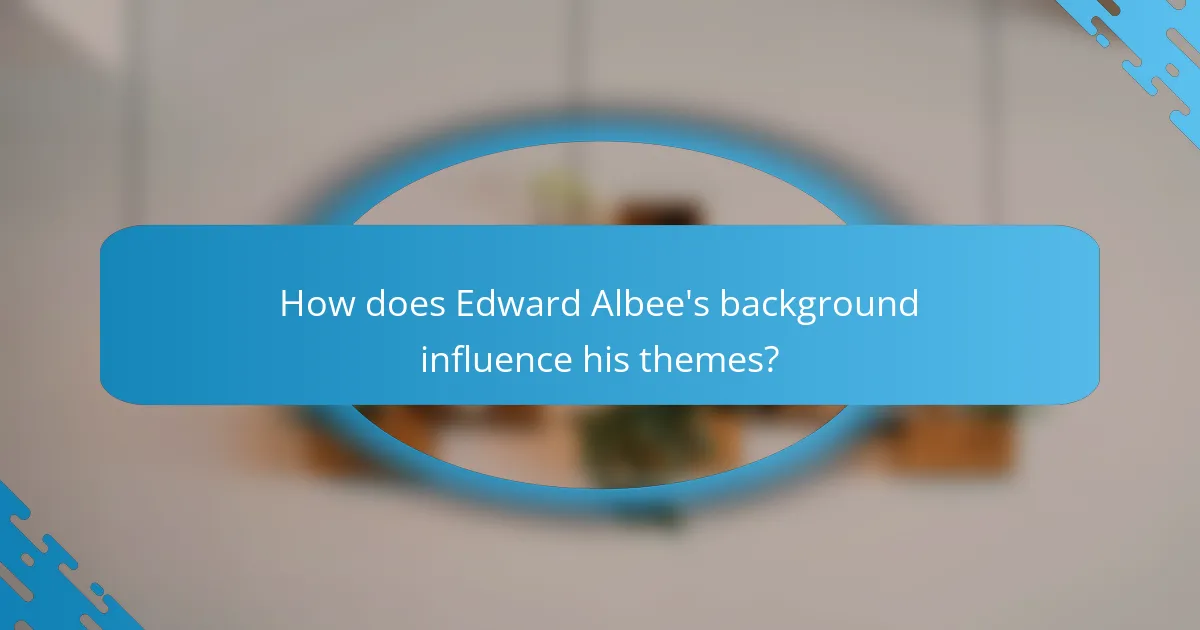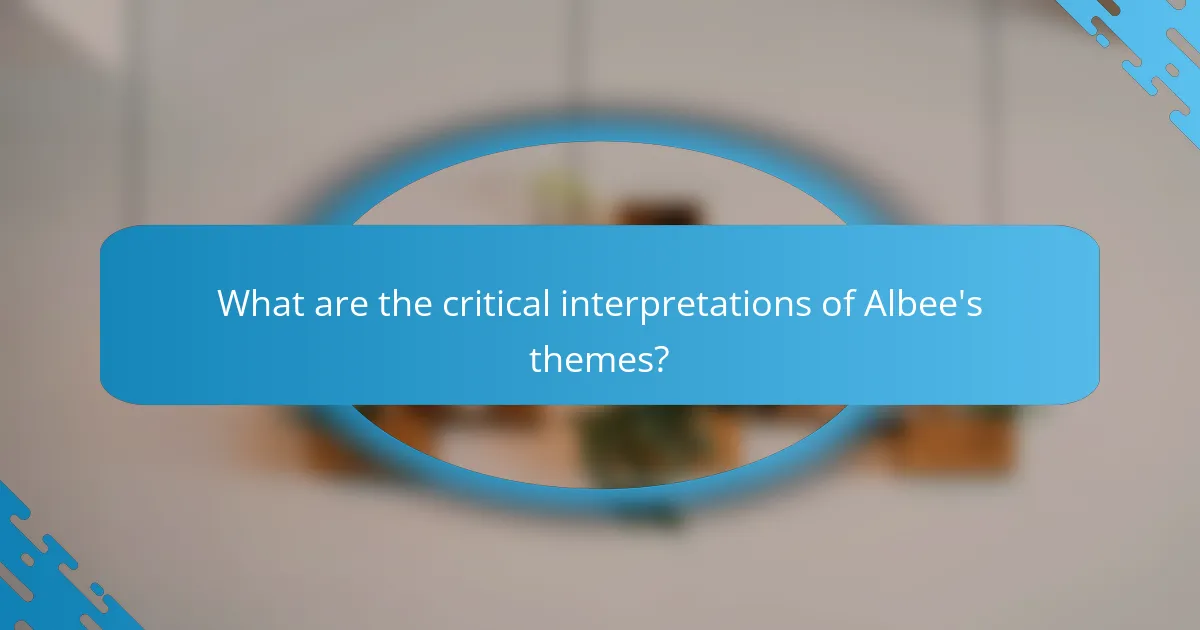Edward Albee is a prominent playwright known for his exploration of key themes such as communication, isolation, and the human condition. His works often depict the complexities of human relationships, highlighting struggles for connection and the resulting feelings of loneliness and existential despair. Albee’s background, including his experiences in a dysfunctional family and as a member of New York’s artistic community, significantly influences his thematic focus. Critical interpretations of his plays reveal recurring motifs of isolation and the breakdown of communication, underscoring the barriers to genuine interaction among characters. Notable plays like “Who’s Afraid of Virginia Woolf?” and “The Zoo Story” exemplify these themes, making Albee’s contributions to drama both significant and profound.

What are the key themes in Edward Albee’s works?
Key themes in Edward Albee’s works include communication, isolation, and the human condition. Albee often explores the complexity of human relationships. His characters frequently struggle to connect with one another. This struggle highlights themes of loneliness and existential despair. Albee’s plays also question the nature of reality and illusion. The tension between appearance and truth is a recurring motif. His works often reflect a critique of societal norms and expectations. Albee’s use of language reveals deeper emotional truths. These themes are evident in notable plays such as “Who’s Afraid of Virginia Woolf?” and “The Zoo Story.”
How does communication manifest in Albee’s dramas?
Communication in Albee’s dramas often manifests through disconnection and misunderstanding. Characters engage in dialogue that reveals their emotional isolation. This form of communication highlights the struggle for genuine connection. For instance, in “Who’s Afraid of Virginia Woolf?”, the verbal sparring serves to expose deeper insecurities. Albee uses language as a tool for both confrontation and revelation. The dialogue often oscillates between clarity and ambiguity, reflecting the complexities of human relationships. The characters’ failure to communicate effectively underscores the theme of isolation. Albee’s work illustrates that communication can be both a bridge and a barrier in relationships.
What role does dialogue play in conveying themes of isolation?
Dialogue serves as a crucial tool in conveying themes of isolation. In Edward Albee’s works, dialogue often reveals characters’ emotional distances. Characters may speak at cross purposes, highlighting their inability to connect. This disconnection emphasizes their profound sense of loneliness. Albee uses pauses and silences within dialogue to further illustrate isolation. These moments create tension and underscore the absence of genuine communication. For example, in “Who’s Afraid of Virginia Woolf?”, the fragmented conversations reflect the characters’ emotional estrangement. Thus, dialogue not only advances the plot but also deepens the exploration of isolation.
How do characters express their needs and desires through communication?
Characters express their needs and desires through verbal and non-verbal communication. They often use dialogue to articulate their feelings and intentions directly. For instance, in Edward Albee’s works, characters frequently engage in intense conversations that reveal their inner struggles. Non-verbal cues, such as body language and [censured] expressions, also convey unspoken desires.
Characters may employ sarcasm or irony to mask vulnerability while still hinting at their true needs. This complexity in communication highlights the theme of isolation, as characters often fail to connect meaningfully despite their attempts. Albee’s characters exemplify this struggle, showcasing how communication can both bridge and widen emotional gaps.
In what ways does isolation impact Albee’s characters?
Isolation profoundly impacts Albee’s characters by intensifying their emotional struggles and communication barriers. Characters often experience profound loneliness, which leads to existential crises. For instance, in “Who’s Afraid of Virginia Woolf?”, Martha and George’s isolation fuels their destructive interactions. Their inability to connect highlights the theme of disconnection in relationships. Isolation also manifests in characters’ desperate attempts for validation and understanding. Albee illustrates how isolation breeds anxiety and despair, as seen in “The Zoo Story.” Jerry’s profound loneliness drives him to confront another character, illustrating the lengths individuals go to escape isolation. Ultimately, Albee uses isolation to expose the fragility of human connections and the complexities of communication.
What psychological effects of isolation are depicted in his plays?
Isolation in Edward Albee’s plays leads to profound psychological effects, including despair, anxiety, and disconnection. Characters often experience a sense of alienation from themselves and others. This emotional detachment manifests in their inability to communicate effectively. For instance, in “Who’s Afraid of Virginia Woolf?”, the characters’ isolation results in a toxic dynamic fueled by manipulation and denial. Albee illustrates how isolation exacerbates mental distress and fosters a cycle of loneliness. The characters’ struggles reflect real-world implications of isolation, emphasizing its detrimental impact on mental health. Their interactions reveal a desperate yearning for connection, ultimately highlighting the tragedy of human isolation.
How does isolation influence character relationships in Albee’s works?
Isolation in Albee’s works deeply affects character relationships. It creates barriers that hinder communication and understanding. Characters often experience profound loneliness, leading to conflict and tension. For instance, in “Who’s Afraid of Virginia Woolf?”, isolation drives George and Martha to engage in destructive behaviors. Their inability to connect highlights the emotional distance between them. Similarly, in “The Zoo Story,” isolation leads to a confrontation that reveals underlying truths about human connection. Albee’s portrayal of isolation emphasizes the struggle for intimacy amidst profound disconnection. This theme is consistent across his plays, showcasing how isolation shapes interactions and relationships.

How does Edward Albee’s background influence his themes?
Edward Albee’s background significantly influences his themes of communication and isolation. Albee was born in 1928 in Virginia and raised in a dysfunctional family. His adoptive parents had high expectations, leading to feelings of alienation. This sense of isolation permeates his works, reflecting the struggles of human connection. Albee’s experiences as a [censured] man in mid-20th century America also inform his exploration of identity and societal norms. His time in New York’s artistic community exposed him to diverse perspectives, further shaping his thematic focus. Albee’s plays often depict the breakdown of communication, mirroring his own life experiences. Thus, his background is integral to understanding the depth of his thematic concerns.
What personal experiences shaped Albee’s perspective on communication?
Edward Albee’s perspective on communication was shaped by his experiences of isolation and personal relationships. He faced a tumultuous childhood marked by feelings of alienation. Albee was adopted, which contributed to his sense of disconnection. His interactions with family were often strained, influencing his views on communication dynamics. Albee’s relationships with partners and friends also informed his understanding of dialogue and conflict. He observed that miscommunication often led to deeper isolation among individuals. These personal experiences became central themes in his plays, highlighting the complexities of human interaction. Albee’s works frequently explore the barriers to effective communication, reflecting his life experiences.
How did Albee’s upbringing inform his views on isolation?
Edward Albee’s upbringing significantly shaped his views on isolation. He experienced a tumultuous childhood marked by a lack of emotional connection. Albee was adopted at a young age, which contributed to feelings of alienation. His adoptive parents had high expectations, leading to a sense of inadequacy. This environment fostered a belief that isolation is inherent to the human condition. Albee’s works often reflect characters grappling with loneliness and disconnection. His personal experiences provided a lens through which he explored these themes in his plays. The influence of his upbringing is evident in the dialogue and interactions of his characters. Albee’s perspective on isolation remains a central theme in his dramatic oeuvre.
What influences from contemporary society are reflected in his dramas?
Edward Albee’s dramas reflect various influences from contemporary society, particularly themes of communication and isolation. His works often explore the complexities of human relationships in a modern context. Albee addresses issues such as societal expectations, existential angst, and the breakdown of communication. For example, in “Who’s Afraid of Virginia Woolf?”, he critiques the disillusionment of American suburban life. The characters’ struggles mirror the alienation felt in a rapidly changing society. Albee’s use of sharp dialogue highlights the difficulty of authentic connection among individuals. His dramas serve as a commentary on the emotional void in contemporary existence. These influences resonate with audiences, making his work relevant to discussions on modern human experience.
How do societal norms affect the themes of communication and isolation?
Societal norms significantly influence the themes of communication and isolation. These norms dictate acceptable behaviors and communication styles within a community. When individuals conform to these norms, they may suppress genuine expressions. This suppression can lead to feelings of isolation, as true thoughts and feelings remain unshared. In contrast, deviation from societal norms can foster open communication. However, it may also result in social ostracism. For instance, in Edward Albee’s works, characters often struggle to connect due to societal expectations. This struggle highlights the conflict between individual identity and societal pressures. Thus, societal norms create barriers that affect both communication and feelings of isolation.

What are the critical interpretations of Albee’s themes?
Critical interpretations of Albee’s themes often focus on communication and isolation. His works explore the complexities of human relationships. Albee frequently depicts characters struggling to connect. This struggle highlights the barriers that prevent genuine communication. Critics note that isolation is a recurring motif in his plays. Characters often find themselves trapped in their own emotional worlds. Albee’s use of absurdity emphasizes the futility of their attempts to reach out. The theme of existential despair is also prevalent. Critics argue that this reflects the human condition in a fragmented society.
How have scholars analyzed the theme of communication in Albee’s plays?
Scholars have analyzed the theme of communication in Albee’s plays as a reflection of human disconnection. They emphasize the complexity of dialogue and its role in revealing character intentions. Albee’s characters often engage in fragmented conversations that highlight their emotional isolation. Research indicates that this communication style mirrors societal issues of misunderstanding and alienation. For example, in “Who’s Afraid of Virginia Woolf?”, scholars note how the characters’ dialogues expose their vulnerabilities. This analysis shows that Albee uses communication to depict deeper existential themes. Additionally, studies highlight how silence in his plays serves as a powerful communicative tool. Overall, Albee’s exploration of communication underscores the struggle for connection in a fragmented world.
What are the most common interpretations of his use of language?
The most common interpretations of Edward Albee’s use of language focus on communication barriers and existential themes. Albee often portrays language as inadequate for true expression. This highlights the isolation of characters in his plays. Critics note that his dialogue often reveals more through subtext than explicit meaning. Albee’s characters frequently engage in verbal sparring, which reflects their emotional struggles. The use of fragmented speech illustrates the chaos of human relationships. Additionally, his language often challenges societal norms and expectations. This complexity invites audiences to explore deeper philosophical questions about existence and connection.
What insights do critics offer regarding isolation in Albee’s work?
Critics highlight that isolation is a central theme in Edward Albee’s work. They observe that his characters often experience profound loneliness and disconnection. This isolation reflects broader societal issues and personal struggles. Critics note that Albee uses dialogue to reveal the characters’ emotional barriers. The lack of genuine communication intensifies their sense of isolation. Works like “Who’s Afraid of Virginia Woolf?” illustrate this theme vividly. Critics argue that Albee’s portrayal of isolation challenges audiences to confront uncomfortable truths. This insight emphasizes the psychological depth of his characters and their circumstances.
How do different critics view the portrayal of loneliness in his dramas?
Critics view the portrayal of loneliness in Edward Albee’s dramas as profound and multifaceted. Many highlight the existential aspects of isolation present in his works. Albee’s characters often experience deep emotional disconnection. This reflects broader themes of human alienation. Critics note that this loneliness is not merely physical but also psychological. Some emphasize the use of dialogue to reveal inner turmoil. Others point to the stark settings that amplify feelings of isolation. Overall, critics agree that Albee’s exploration of loneliness is central to understanding his dramatic impact.
What practical lessons can be learned from Albee’s exploration of communication and isolation?
Albee’s exploration of communication and isolation teaches the importance of authentic dialogue. Genuine communication fosters deeper connections among individuals. Conversely, superficial interactions can lead to feelings of loneliness. Albee illustrates this through characters who struggle to express their true selves. For example, in “Who’s Afraid of Virginia Woolf?”, the couple’s inability to communicate leads to emotional estrangement. This highlights that effective communication is essential for healthy relationships. Additionally, Albee’s works suggest that isolation can stem from misunderstandings and societal expectations. Recognizing and addressing these barriers can enhance interpersonal relationships.
The main entity of this article is Edward Albee, a prominent playwright known for his exploration of themes related to communication and isolation in drama. The article examines key themes in Albee’s works, highlighting how communication manifests through disconnection and misunderstanding among characters. It discusses the psychological effects of isolation, the role of dialogue in conveying emotional distances, and the influence of societal norms on character relationships. Additionally, the article analyzes critical interpretations of Albee’s themes and offers practical lessons derived from his exploration of authentic communication.



